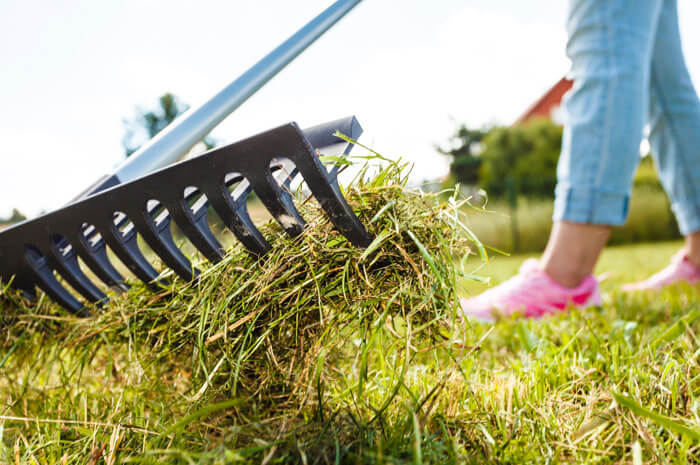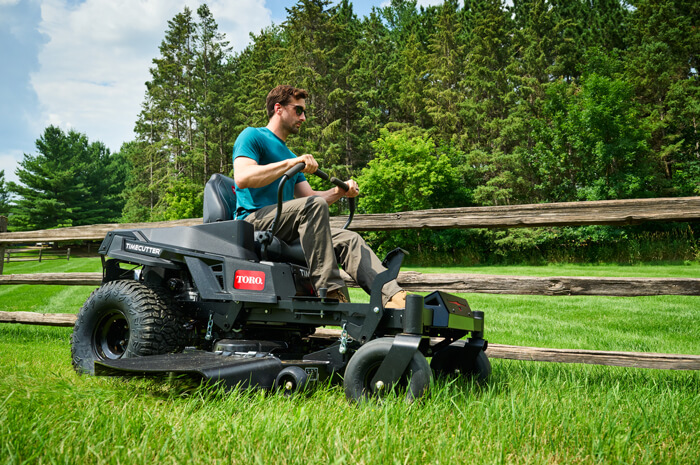
Are you wondering how to revive your grass after a long winter? Unsightly, patchy spring grass is a problem that many homeowners across the country face. Of course, the harsher the winter, the more potential problems for your lawn. But, with the proper care, your grass can bounce back even after the harshest of winters, returning to its full glory by summer.
So, let’s discuss how to bring back grass after winter, promoting a full, healthy lawn that’ll leave your neighbors green with envy.
Step 1: Rake & Dethatch
This step requires patience, which could be difficult for some homeowners growing tired of their dead, patchy grass after winter. However, raking too soon may cause more harm than good.
After winter, grass tends to be somewhat delicate and vulnerable, as it hasn’t properly rooted yet. It’s best to wait until your lawn starts to green up – a sign that your grass is starting to root firmly into the ground. At this point, it’s okay to start raking, although you’ll still want to be careful.
You’ll likely find a thin layer of thatch – tangled clumps of roots, stems, and shoots – gathered at the base of the grass. A thin layer of thatch actually promotes a healthy lawn, however, if the thatch is too thick (an inch or more) it can prevent water and nutrients from getting to your grass. Work to gently remove any excess thatch or dead material from your lawn.
Step 2: Assess the Soil & Aerate if Necessary
While the quality of your soil depends on many factors, one problem stands out for being common, easy to detect, and relatively straightforward to address: soil compaction. Over time, soil can become tramped down by foot traffic, tire tracks, or other repeated forces. If your lawn seems to be getting less healthy over the years, it’s quite possibly due to compacted soil.
Walk around your lawn, paying attention to the feel of the soil beneath your feet. If you notice any areas where the ground seems especially hard, you probably need to aerate. Aeration helps to loosen compacted soil, reintroducing the oxygen, water, and nutrients that have been smothered out over time.
Step 3: Clear & Seed Dead Patches
If you have any dead patches of grass that you need to revive after winter, it’s best to address them now. Start by clearing away all of the surrounding thatch and debris, if you haven’t done so already in step one.
Now that the bare spots are exposed, prep the soil by scoring it with a rake, or anything else that loosens the surface. Find an appropriate grass seed and spread it over the loosened soil. If you have extra soil or compost, you can spread a thin layer – about half an inch or so – over the seed. Otherwise, gently mix the seed into the surface of your existing soil. This will help to keep the seed in place and from being eaten by hungry birds.
Keep the seeds moist by watering them once or twice a day, for around 10 days, until the seeds start sprouting. Continue to closely monitor this sprouting grass, letting it grow slightly taller than the rest of your lawn before you start mowing it.
Step 4: Weed Your Lawn With Pre-Emergent Herbicides
When it comes to herbicides, there are several options on the market, not all of which are appropriate to put on your grass after winter. There are selective, non-selective, pre-emergent, and post-emergent products available in liquid or granule form.
Selective vs. Non-selective
Selective herbicides are designed to target and kill problematic weeds while causing no harm to other plants. Non-selective herbicides, on the other hand, will kill any type of plant it comes into contact with. Find a herbicide that works for your yard, spritzing moderately to keep your yard looking pristine.
Pre-emergent vs. Post-emergent
As the name suggests, pre-emergent herbicides are used before weeds, such as crabgrass, thistle, or clover, start to grow in. Post-emergent herbicides are used reactively, not proactively, to eliminate weeds that have already sprung up.
If you’re able to think about weeding early enough in the season, pre-emergent herbicides can be quite effective, especially when paired with post-emergent herbicides later on during spring. These herbicides are easy to use, requiring only a spreader or sprayer, depending on the form.
Note that, if you have newly seeded patches of grass, you should avoid applying herbicides to those areas for around six weeks.
Step 5: Fertilize the Grass
Once all of the herbicides have been absorbed into the grass, it’s time to fertilize. Fertilizer provides a ton of energy to your grass, which is needed for optimal growth. Unless your grass is already thick and green, fertilizing is necessary for a picturesque lawn.
Soil alone is rarely able to provide all the necessary nutrients throughout the entire growing season. Because of this, bringing back grass after winter can be especially hard without fertilizer, too, especially in colder climates.
Step 6: Start the Sprinklers
In colder climates, rainfall alone typically provides enough moisture for emerging spring lawns. In warmer climates, where lawns are periodically watered throughout the winter, it’s best to keep up with this cadence through early spring.
In both scenarios, it’s important to ramp up watering as your grass comes to life. This is especially true after fertilization, helping those essential nutrients get absorbed into the grass roots. Don’t be tempted to start watering early as a way of greening up your grass early – instead, wait until it’s ready to take on additional moisture.
Step 7: Start to Mow, But Not Too Low
Once the ground is dry, and the grass has grown tall, you’re free to start mowing. But, right after the winter season, it’s important to leave the grass fairly long. Cutting your grass too low during the spring can encourage weed growth, exposing seedlings and dormant weeds to the energy of the sun.
Cutting grass too low also limits the surface area needed for photosynthesis, ultimately weakening your lawn. So, for the first few cuts of the season, make sure you’re on a higher cutting height.
How To Bring Back Grass After Winter: An Overview
Once you’ve raked and dethatched, aerated (if necessary), seeded any dead patches, applied seasonally appropriate herbicides, fertilized, and started to water and mow, you’ll be well-positioned for a healthy and prosperous growing season. This will create a yard that is both beautiful and functional, adding plenty of value to your home.



